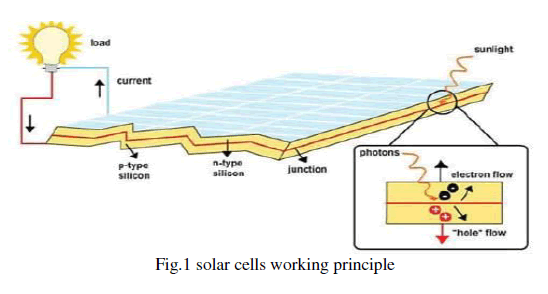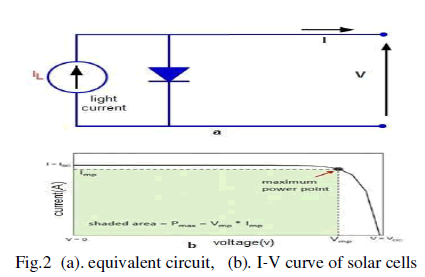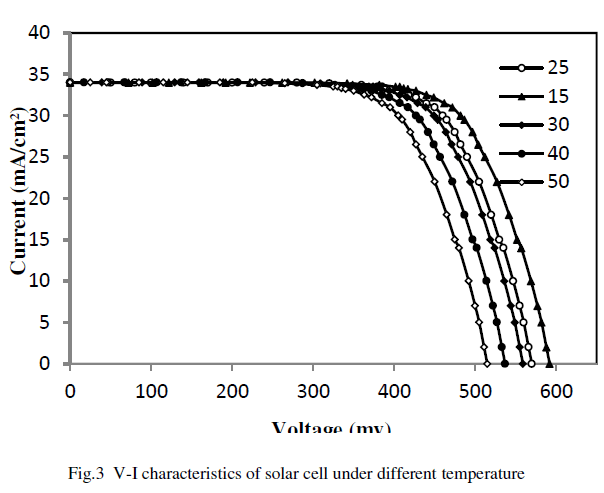ISSN ONLINE(2278-8875) PRINT (2320-3765)
ISSN ONLINE(2278-8875) PRINT (2320-3765)
Davud Mostafa Tobnaghi1, Rahim Madatov2, daryush naderi1
|
| Related article at Pubmed, Scholar Google |
Visit for more related articles at International Journal of Advanced Research in Electrical, Electronics and Instrumentation Engineering
In this paper, the performance and overview use of solar cells is expressed. The role of temperature on the electric parameters of solar cells has been studied. Experimental results shows that all electrical parameters of solar cell such as maximum output power, open circuit voltage, short circuit current, and fill factor Have changed with temperature variation. As well as the amount of changes in these parameters in terms of temperature value have been obtained. According to results, the most significant is the temperature dependence of the voltage which decreases with increasing temperature while the current of cells slightly increases by temperature.
Keywords |
| maximum output power, open circuit voltage, short circuit current, solar cells, temperature |
INTRODUCTION |
| Nowadays we get approximately 80% of our energy from non-renewable energy sources, e.g. fossil fuels. Pollutants and greenhouse gases increase when fossil fuels are converted into electricity or heat. Therefore atmosphere is damaged and global warming developed. Fortunately, as the resources are limited, our dependence on fossil is close to its end. Presently, the world annual energy consumption is 10 terawatts (TW) and by 2050 this amount will be about 30 TW. The world will need about 20 TW of non-CO2 energy to stabilize CO2 in the atmosphere by mid-century. The simplest scenario to stabilize CO2 by mid-century is one in which photovoltaics (PV) and other renewable are used for electricity (10 TW), hydrogen for transportation (10 TW), and fossil fuels for residential and industrial heating (10 TW) [1]. Thus, PV systems will a significant role in the world energy supply in the future. |
| Photovoltaic systems have been installed to provide electricity to the billions of people that do not have access to mains electricity. Power supply to remoter houses or villages, irrigation and water supply are important application of photovoltaics for many years to come. In the last decade, PV solar energy system has shown its huge potential. The amount of installed PV power has rapidly increased. Nowadays, nearly 70 GW of PV power are installed worldwide. Perhaps the most exciting new application has been the integration of solar cells into the roofs and facades of buildings during the last decade. |
| Solar cells are based on semiconductor materials. semiconductor are materials from either group IV of the periodic table, or from a combination of group III and group V, or of combinations from group II and group VI. The sun radiates in all regions of spectrum, ranging from radio waves to gamma ray. Our eyes are sensitive to wavelengths ranging from 400-700 nm. In this narrow range, called visible range, the sun emits about 45% of total radiated energy. Nearly 80% of cells on the market are crystalline silicon based cells. |
| Solar cell properties can be altered by changes in environmental conditions such as temperature. Typically solar cells are used at the temperature range between 5 to 50 °c .In this paper, temperature dependency of solar cells electric parameters such as open circuit voltage, fill factor, short circuit current and efficiency is investigated. |
II. SOLAR CELLS OPERATION |
| The photovoltaic (PV) effect is the direct conversion of light into electricity in solar cells. When solar cells are exposed to sunlight, electrons excite from the valence band to the conduction band creating charged particles called holes. In one PV cell, the upper or nâÃâ¬ÃÂtype layer is crystalline silicon doped with phosphorus with 5 valence electrons while the lower or pâÃâ¬ÃÂtype layer is doped with boron, which has 3 valence electrons. By bringing N and P type silicon (semiconductors) together, a p-n junction serves for creating an electric field within the solar cells, which is able to separate electrons and hole and if the incident photon is energetic enough to dislodge a valance electron, the electron will jump to the conduction band and initiate a current coming out from the solar cells through the contacts [2]. Figure 1 shows this process. |
 |
A. I-V Characteristics of Solar Cells |
| The equivalent circuit of the solar cells is combination of a current source (light generated current) and a diode. Solar cells behave similarly to diodes and thus the electrical characteristics of solar cells represented by using current-voltage curves (I-V curve). Figure 2 shows the IâÃâ¬ÃÂV characteristics and the equivalent circuit of solar cells. |
 |
| Isc represents the short circuit current, at which the current is at maximum and where voltage is zero. Voc is open circuit voltage, at which the voltage is maximum and where current is zero. The maximum power Pmax produced by a solar cell is reached when the product I-V is maximum. This can be shown graphically (fig. 2.b) where the maximum output power represents the largest rectangle area under the I-V curve. The basic equation for solar cells is follow: |
 |
| Where k is the Boltzman constant, T is the temperature in terms of Kelvin, q is Electric charge, V is output voltage of solar cell, IL is light generated current, and I0 is the reverse saturation current[3-5]. |
III. EXPERIMENTAL METHODS |
| The one sample of the commercially solar cells is used for experimental measurements. The solar cell was fabricated mono-crystalline structure with using phosphorus diffusion into a p-type silicon wafer. Voltage-current (I-V) characteristics and output parameters of solar cell was measured. To obtain of solar cell I-V characteristics, sample was illuminated by reflective lamp with Light intensity equal to1000 W/m2 (AM 1.5). The measurements were performed at 15, 25, 30, 40, and 50 0c temperatures by highly accurate measuring equipment at the institute of Radiation Problems of Azerbaijan National Academy of science. |
IV. RESULTS AND DISCUSSION |
| Voltage-current characteristics of solar cell sample at 15, 25, 30, 40, and 50 0c temperatures have been shown in figure 3. As can be seen, V-I characteristics of solar cell vary under different temperature. Increases in temperature reduce the band gap of a solar cell, whereby effecting the solar cell electrical parameters [4, 5]. |
 |
| The parameter that most affected by temperature is Voc. According to equation 2, the open-circuit voltage decreases with temperature due to the temperature dependence of the reverse saturation current (I0). |
 |
| Where: |
| D is the diffusivity of the minority carrier given; |
| L is the diffusion length of the minority carrier; |
| ND is the doping; |
| q is the electronic charge; |
| In the above equation, intrinsic carrier concentration (ni) has most significant on I0 due to the lower band gaps giving a higher intrinsic carrier concentration so higher temperatures results the higher ni. |
| From figure 3, fundamental parameters of solar cells like open circuit voltage (Voc), short circuit current (Isc), fill factor (ff) and efficiency (η) could be extracted [6, 7]. Table 1 shows the output parameters of solar cell simple under different temperature. |
 |
 |
V. CONCLUSION |
| The Performance of solar cells is dependent on environmental conditions and their output parameters such as output voltage, current, power, and fill factor vary by temperature. Experimental results showed that the most significant changed by temperature is voltage which decreases with increasing temperature while output current slightly increase by temperature. Reduction in the open-circuit voltage for silicon solar cells is about 2mV/°C. As well as the effect of temperature on the maximum power output is menus 0.005 mw/°C. The best performance of solar panels in sunny and cold day has been suggested. |
ACKNOWLEDGMENT |
| The authors acknowledge the supports given by Azad university of Parsabad Moghan Branch and Institute of Radiation Problems of Azerbaijan Academy of Sciences for technical assistance in the gamma irradiation work |
References |
|